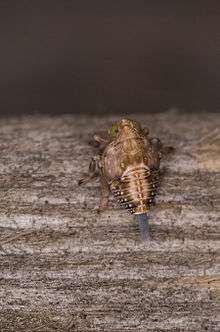Issus (genus)
| Issus | |
|---|---|
| | |
| Issus species | |
| Scientific classification | |
| Kingdom: | Animalia |
| Phylum: | Arthropoda |
| Subphylum: | Hexapoda |
| Class: | Insecta |
| Order: | Hemiptera |
| Suborder: | Auchenorrhyncha |
| Infraorder: | Fulgoromorpha |
| Family: | Issidae |
| Genus: | Issus Fabricius, 1803 |

Issus is a genus of 'planthoppers' belonging to the family Issidae of infraorder Fulgoromorpha of suborder Auchenorrhyncha of order Hemiptera. Like most members of the order Hemiptera (popularly known as the "bug" or "true bugs" order) they live on phloem sap that they extract with their piercing, sucking mouth parts.
Planthoppers are the only animals known to evolve a locomotive gear mechanism, and Issus coleoptratus is the first type of planthopper to have the mechanism formally described.[1][2][3] The gears in the insect legs are not connected to power ratios, and only synchronise the action of the jumping legs.
Description
The genus Issus includes small insects generally flightless with a stocky, brown body and forewings with strong pronounced ribs. They feed on phloem. Species of this genus are present in most of Europe, in the Near East and in North Africa.
Gear mechanism

Planthoppers are the first animals found to contain a biological form of a mechanical gear, used in locomotion (crocodiles possess a heart valve with cog-like projections, but they have no cog-like function[4]), and the first formal description of this mechanism was in the species Issus coleoptratus; the gears keep the legs in synchronization, allowing the bugs to jump accurately at an acceleration of nearly 400 gs in two milliseconds.[1] The existence of the gears in planthoppers had been known for decades,[5] but zoologist Gregory Sutton and his co-authors only recently characterized their functional significance by doing high-speed photography of the insects at Cambridge University.[1][6][7] The gears are found only in the nymph forms of all planthoppers, and are lost during the final molt to the adult stage.[2] It is suspected that gears are lost in the adult after the last molt because if broken they would be irreparable, crippling the insect for life.[2] Prior to their discovery, it was assumed only humans had used gears.[3]
List of species
This genus include the following 29 species:
- Issus analis Brullé, 1832
- Issus bellardi Melichar, 1906
- Issus bimaculatus Melichar, 1906
- Issus cagola Remane, 1985
- Issus cagracala Remane, 1985
- Issus cahipi Remane 1985
- Issus canalaurisi Sergel, 1986
- Issus canariensis Melichar, 1906
- Issus capala Remane 1985
- Issus capapi Remane1985
- Issus cinereus (Olivier, 1791)
- Issus climacus Fieber, 1876
- Issus coleoptratus (Fabricius, 1781)
- Issus distinguendus Lindberg, 1954
- Issus fieberi Melichar 1906
- Issus fissala Fieber 1876
- Issus gracalama Remane, 1985
- Issus gratehigo Remane, 1985
- Issus hipidus Remane, 1985
- Issus lauri Ahrens, 1818
- Issus maderensis Lindberg, 1956
- Issus muscaeformis (Schrank, 1781)
- Issus padipus Remane, 1985
- Issus paladitus Remane, 1985
- Issus palama Remane, 1985
- Issus pallipes Lucas, 1853
- Issus pospisili Dlabola, 1958
- Issus rarus Lindberg, 1954
- Issus truncatus Fieber, 1876
References
- 1 2 3 Burrows, Malcolm; Sutton, Gregory (2013-09-13), "Interacting gears synchronize propulsive leg movements in a jumping insect", Science, 341 (6151): 1254–1256, doi:10.1126/science.1240284
- 1 2 3 Lee, Jane J. (2013-09-12), "Insects Use Gears in Hind Legs to Jump", National Geographic
- 1 2 "Gears evolved in nature long before humans 'invented' them", theguardian.com, 2013-09-13, archived from the original on 2014-10-08
- ↑ Axelsson, Michael; Franklin, Craig E.; Löfman, Carl O.; Nilsson, Stefan; Grigg, Gordon C. (1996), "Dynamic anatomical study of cardiac shunting in crocodiles using high-resolution angioscopy" (PDF), The Journal of Experimental Biology, 199: 359–65, PMID 9317958
- ↑ Sander, K. (1957), "Bau und Funktion des Sprungapparates von Pyrilla perpusilla WALKER (Homoptera - Fulgoridae)", Zool. Jb. Jena (Anat.) (in German), 75: 383–388
- ↑ Herkewitz, William (2013-09-12), "The First Gear Discovered in Nature", Popular Mechanics
- ↑ Zolfagharifard, Ellie (2013-09-12), "Nature outdoes engineers again: High-speed 'mechanical gears' discovered for the first time on the hind legs of a plant hopping insect", Mail Online
External links
| Wikimedia Commons has media related to Issus (genus). |
